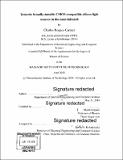| dc.contributor.advisor | Marin Soljačić. | en_US |
| dc.contributor.author | Roques-Carmes, Charles | en_US |
| dc.contributor.other | Massachusetts Institute of Technology. Department of Electrical Engineering and Computer Science. | en_US |
| dc.date.accessioned | 2018-09-17T15:55:17Z | |
| dc.date.available | 2018-09-17T15:55:17Z | |
| dc.date.copyright | 2018 | en_US |
| dc.date.issued | 2018 | en_US |
| dc.identifier.uri | http://hdl.handle.net/1721.1/118049 | |
| dc.description | Thesis: S.M., Massachusetts Institute of Technology, Department of Electrical Engineering and Computer Science, 2018. | en_US |
| dc.description | Cataloged from PDF version of thesis. | en_US |
| dc.description | Includes bibliographical references (pages 47-52). | en_US |
| dc.description.abstract | The efficient extraction of light from silicon is one of the longstanding challenges of modem engineering and physics. The difficulty mainly arises from silicon's indirect bandgap and the short lifetime of non-radiative processes such as Auger recombination. Nonetheless, the realization of an energy efficient silicon-based photon source could find broad applicability in areas such as ultra-large scale integration (ULSI), optoelectronic displays and lighting. Every practical solution proposed thus far to this fundamental, yet technologically critical problem, relies on the physical patterning or chemical modification of silicon substrates, most of these transformations requiring high annealing temperatures or fabrication steps that are not compatible with conventional ULSI processes. In this thesis, we experimentally demonstrate the generation of tunable radiation in the near-infrared (800 to 1600 nm) from a simple periodic silicon grating. The light emission is generated by spontaneous emission from these gratings interacting with low-energy free electrons (as low as 2 keV) and is recorded in the silicon transparency window. We develop time-domain numerics that confirms our experimental results and our evaluation of the output radiation power. In addition, we theoretically investigate the feasibility of an allsilicon compact tunable radiation source at telecommunication wavelengths comprised of a silicon Field Emitter Array (FEA) integrated with a silicon periodic structure. Our results pave the way towards the realization of a CMOS-compatible electrically-pumped silicon light source. | en_US |
| dc.description.statementofresponsibility | by Charles Roques-Carmes. | en_US |
| dc.format.extent | 52 pages | en_US |
| dc.language.iso | eng | en_US |
| dc.publisher | Massachusetts Institute of Technology | en_US |
| dc.rights | MIT theses are protected by copyright. They may be viewed, downloaded, or printed from this source but further reproduction or distribution in any format is prohibited without written permission. | en_US |
| dc.rights.uri | http://dspace.mit.edu/handle/1721.1/7582 | en_US |
| dc.subject | Electrical Engineering and Computer Science. | en_US |
| dc.title | Towards broadly-tunable CMOS-compatible silicon light sources in the near-infrared | en_US |
| dc.title.alternative | Towards broadly-tunable CMOS-compatible silicon light sources in the near-infrared | en_US |
| dc.type | Thesis | en_US |
| dc.description.degree | S.M. | en_US |
| dc.contributor.department | Massachusetts Institute of Technology. Department of Electrical Engineering and Computer Science | |
| dc.identifier.oclc | 1051459919 | en_US |
